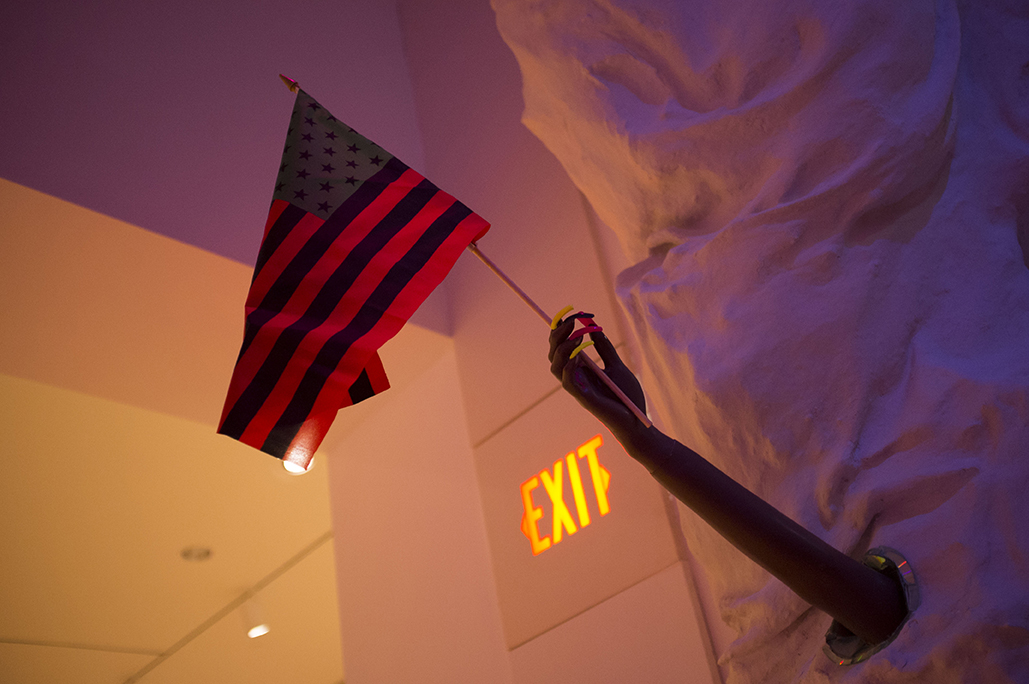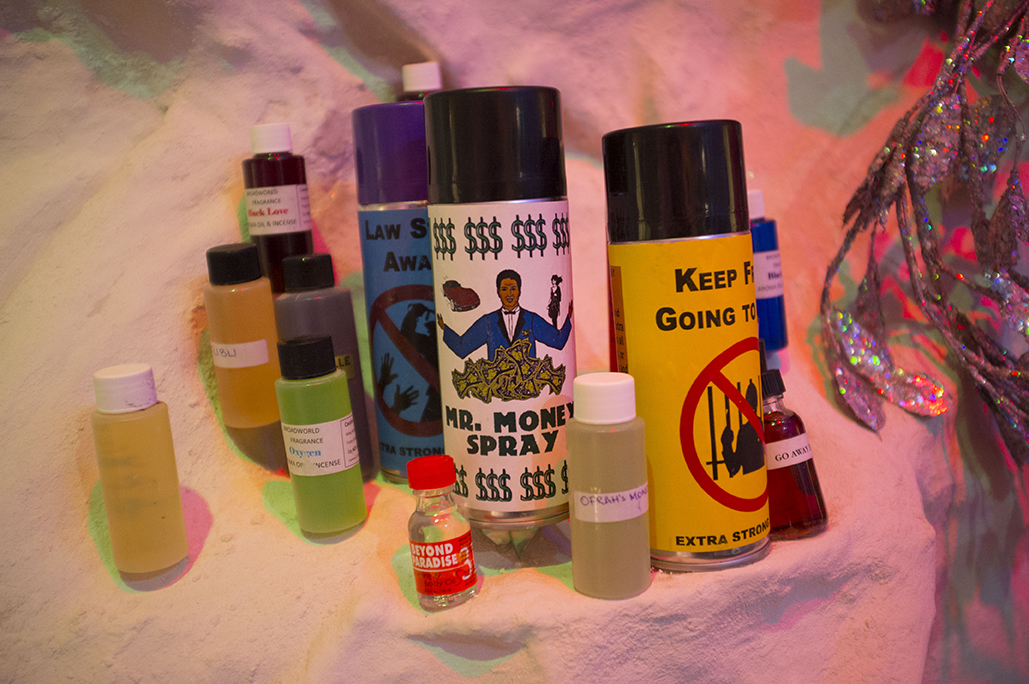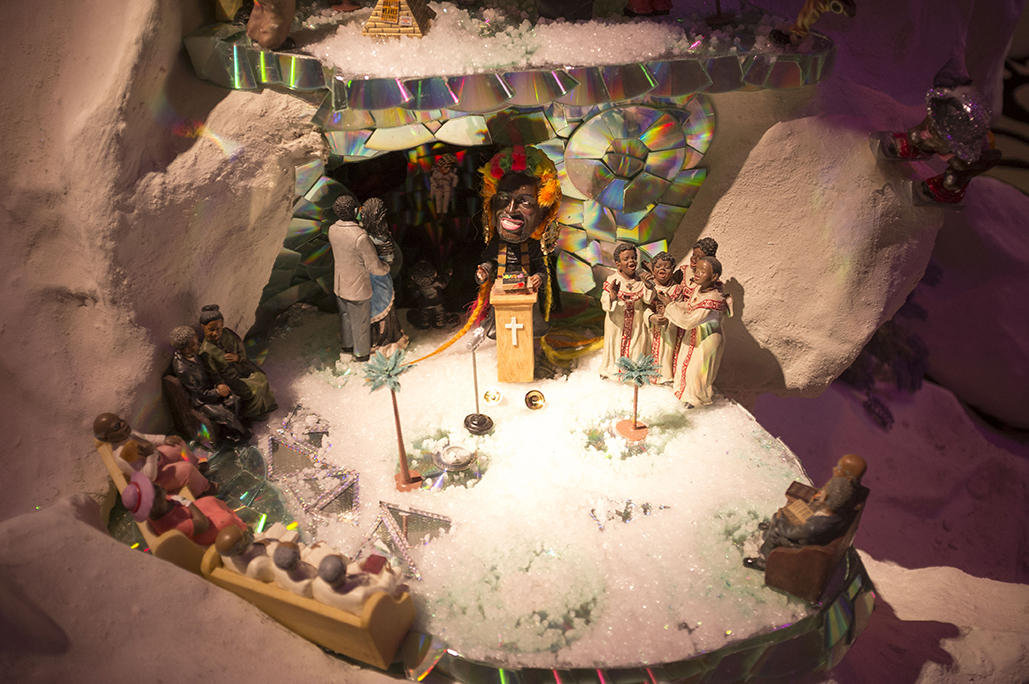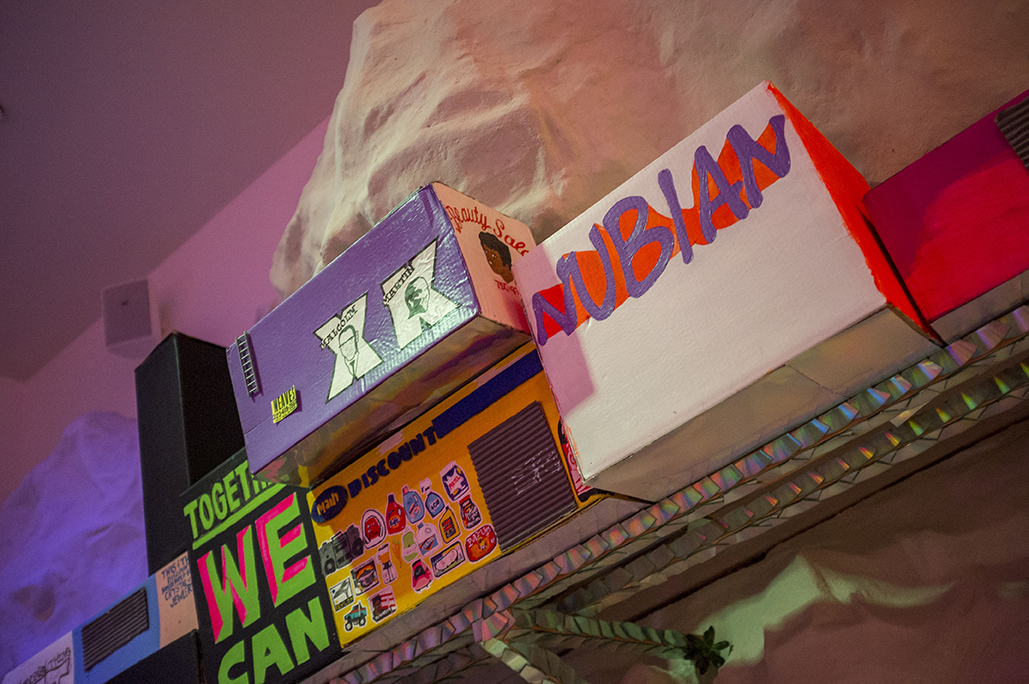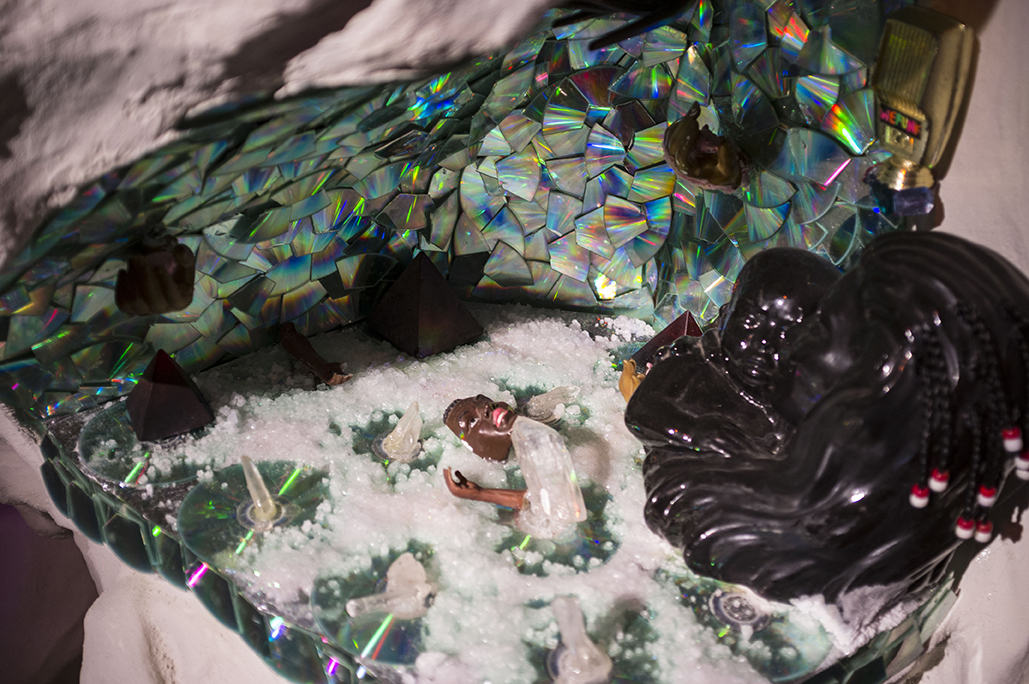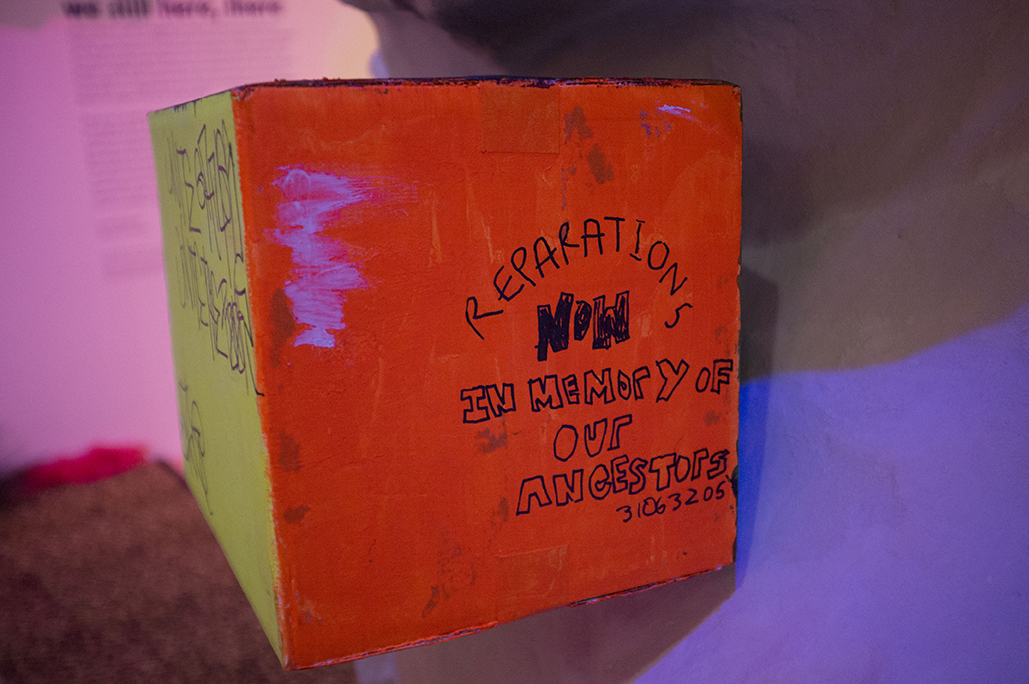text by Taliah Mancini
photographs by Oliver Kupper
Lauren Halsey’s dream-world is cosmic, funky, carpeted, and technicolored; an atemporal, fantastical, and hyperreal vision of black liberation which she conjures via site-specific installations that celebrate her childhood home.
Iconography and aesthetics (not to mention philosophy, lived experiences, and informal economies) of the diaspora serve as Halsey’s blueprint. Manipulating found objects and cultural artifacts from South Central, she deftly plays the past and present off one another to build a black utopia outside of time. Incorporating, for example, smashed-CD’s, aquarium plants, artificial crystals and rocks, hair extension packs, incense oils, aerosol spray cans, pan-African flags, tchotchkes, figurines, and black-business signage, she shapes a community-based, architecturally-rooted, afro-futurist cosmology.
Perhaps most explicitly, Halsey’s work is embedded in a spatial analysis of racial capitalism. Recognizing the power of oppressive built environments, she works to dismantle hegemony’s spatial ordering—a subversive move against cultural erasure and panoptical city planning. In response to the calculated displacement targeting South Central, she invests in her own architecture, preserving black-owned shops and community spaces by archiving her long-time home. She not only presents a cutting critique of the modern consumer economy but also an active re-constructing of heterotopia.
Creatively and politically, Halsey has carved out a space for herself in an art world that is often complicit in the very systems she re-imagines. With installations that are reminiscent of few conventional object-oriented art works, she is creating a new visual genre, pushing those who enter her fantasy to re-envision the perspective-altering potentials of the visual, aural, sensorial, and spatial. And, firmly rooted in love for her neighborhood, her work is defined in equal measure by healing from trauma and honoring history. Halsey’s dream-world is a moving through abuse to create new realities; an optimistic, grounded, and empowered archiving of the future.
TALIAH MANCINI: To start, what does your neighborhood mean to you?
LAUREN HALSEY: Neighborhood Pride, Gorgeous color palettes and aesthetics, Black history as it relates to The Great Migration, Family History, My future.
MANCINI: When did you begin creating art?
HALSEY: Intentionally in the 12th grade. Oddly enough one of our first art projects was a carving project that I’m revisiting for my upcoming public project, The Crenshaw District Hieroglyph Project. I was already intrigued and deeply obsessed with collecting and creating records in my notebooks. The 12th grade carving project gave me the form.
MANCINI: I’ve seen pictures of your early maximalist collages. Did your documenting of South Central emerge with these Photoshopped images?
HALSEY: No, documenting and archiving signs, posters, mix CDs, parties, menus, incense n oils, party flyers, hairstyles, bus routes, businesses, knick knacks, t-shirts, greeting cards, local landmarks, city blocks, voices, etc. was already happening. I used the archive I was engaging to create the maximalist blueprints of my neighborhood a few years later when I took my first Photoshop class at El Camino Community College.
MANCINI: Your work is, most notably, a community-based practice. Where does that process start, both conceptually and physically?
HALSEY: With all of the odds already stacked against working class black and brown folks in low income neighborhoods in LA (food, education, police, housing, etc), I can’t imagine not having a community-based practice. My interest is to not only affirm folks through my practice/the artwork but most importantly to do so with tangible results: paid jobs, transcendent programming, free resources and workshops. My upcoming public project, The Crenshaw District Hieroglyph Project will address this conceptually and physically. Here’s a blurb on it:
The Crenshaw District Hieroglyph Project (C.D.H.P.) is a hybrid public art installation and community market created in collaboration with the Crenshaw District that will build and reinforce local economies of South Central LA that can sustain the pressures of rapid gentrification. The Crenshaw District Hieroglyph Project will exist on an empty lot where over the course of a 3-6 month public installation, four autonomous 16 ft. hieroglyphic towers with open circulation will be constructed. Each tower will include a series of rooms covered in hieroglyphic-style engravings on the interiors and exteriors. Upon entering the structure, the public will be invited to make their own "hieroglyphs" by carving into a series of blank panels serving as a medium to express narratives, share news, honor community leaders, celebrate events, and leave obituaries or memorials. This visual archive of and for the neighborhood will allow community members the freedom to commemorate and monumentalize themselves and one another in a city (and nation) where the place-making strategies of black and brown subjects are increasingly deleted from the landscape.
Through programming that generates paid jobs and provides tangible resources through free workshops on entrepreneurship, The Crenshaw District Hieroglyph Project provides and examines how alternate modes of community building can take place, while providing community members productive inroads to be engaging with, participating in, and benefiting from the top-down pace of development encouraged by Los Angeles' economic imperatives. Importantly, the public project’s investment in community artmaking will document and inscribe into the four towers the plural experience of communities who rarely benefit from, for example, gentrifying landscapes that privilege the lives and experiences of upwardly mobile middle classes. The towers provide space for the city's most overlooked citizens to describe their iconographies, aesthetic styles, informal economies, leisure activities, celebrations, oppression, local histories, and potential futures in the form of a tangible community monument. It is my hope that the publics' engravings and the informal economies The Crenshaw District Hieroglyph Project creates will inspire productive dialogues about liberation for South Central LA from within, beginning with our dollars.
MANCINI: Your exploration of architecture is brilliant. When did you become interested in re-imagining the built environment?
HALSEY: I’ve always been deeply, deeply, deeply into PFunk. They empowered my imagination at a young age. Early on I was very intrigued by the space making that was happening with PFunk seamlessly on the scale of worlds (outerspace, place, blackness, queerness, me). They beamed me up and into their radical worlds without me ever having to leave my bedroom. They left me totally transformed, always. Who I was/am will always be enough to participate. That relationship to space making carries over to my work where I remix and propose new spaces with what we already have and who we already are, to conjure new reflections on self-determination, affirmation, community wealth building, love, Funk, etc.
My interest in architecture is also biographical as it relates to growing up and living in a LA with so much oppressive architecture and always having questions around who’s building our architecture for us.In architecture school, I became really into the dialog of 60’s/70’s fantasy architecture.
MANCINI: Can you talk about your play with architecture in reference to the resistance of gentrification in South Central?
HALSEY: I can’t omit architecture and our built environment outside of the convo of gentrification. There should be, and are many, responses. I’m interested in responding through interventions with “for us by us architecture.” An architecture that representationally and structurally comes from us to empower us. An architecture that doesn’t signify erasure to disempower us. A Funky architecture. An architecture that comes from our hands.
MANCINI: How do you describe the way funk (Parliament/Funkadelic, Gospel Funk, Jheri Curl Funk, etc.) informs your cosmic black utopia?
HALSEY: Density. Layers. Immersion. Maximalism. Control. Black Style. Black Aesthetics. Deep Time.
MANCINI: What about outer space?
HALSEY: Outer space is limitless. White supremacy, racism classism, sexism, nepotism, consumerism, etc. aren’t the order there. There’s great freedom in contextualizing my projections for the neighborhood in an infinity space without Earth’s baggage.
MANCINI: And nature?
HALSEY: Funkifying nature has a lot to do with my interest in fantasy nature. Seeing nature through Funk sounds. The effect of a Funk nature that’s an assemblage of multiple geographies while remixing and also, sampling place, texture, form via my own renditions of the landscape.
MANCINI: You grew up in South Central, spent time in New Haven for graduate school at Yale, and then moved back to your childhood home. What are your impressions of the LA art communities?
HALSEY: There are so many because of the enormous geographical spread in LA. I spend my downtime in Atlanta. I haven’t been consistently in LA long enough to truly belong to a community, but I think I’m forging one and beginning to join existing ones.
MANCINI: Where (and what) in Los Angeles inspires you?
HALSEY: Black LA, the beaches, the sunsets, bonfires, candy cars, ice cream trucks, the pan man, the elote man, the tamale man, signs, hair, sunsets, taco trucks, freeways at night, hot days, rooftop pools, walking, riding the bus, growing up in church, ceviche, paletas, soul food, my family, chasing lowriders, the roosters, the hills, everything.
MANCINI: How did “we still here, there” at MOCA come about?
HALSEY: I was researching Chinese grotto heavens and became interested in the Mogao Caves. I was intrigued by the cave as a super structure rock form but also, as its function as a transcendental storehouse for culture: research archives of lost cultures, specific histories, discourse and ideas. I proposed to MOCA that I would build a cave-grotto with a series of connected chambers and corridors marking the plurality of black daily cultural experiences in downtown South Central LA. Some chambers include local ephemera and iconographies (i.e. South Central superhero, Okeneus’s original collages, selections of incense n oils, black figurines, mix cds, local newspaper clippings, portraitures, etc.). Other moments will be more speculative, including imaginary of future South Central landscapes, memorials, miniature shrines and statues, poems, rock carvings and soundscapes. Conceptually, I wish to create an aesthetic-sociopolitical record and overview of contemporary South Central in order to mark the evolution and narrative shifts of neighborhoods as they are being increasingly deleted from the LA landscape. Community identities are being lost and some histories aren’t being preserved (i.e. displacement via market-rate condominiums, new stadiums, developments, etc). The long-term goal is to create a permanent public cave-grotto in my neighborhoods that centuries from now will be excavated and inhabited by the future.
MANCINI: It seems like an important component of the installation is you regularly changing the space. What is your role as “pharaoh, high-voltage Funkateer and master architect”?
HALSEY: I can’t give all of my recipes away but in a nutshell, Keep building, Keep visioning, Keep Funking so that the work isn’t a set or an eulogy of itself. It’s a living environment that will accumulate energy, poetics and an archive through the run of the exhibition.
MANCINI: In what ways is the installation connected to your on-going artistic project?
HALSEY: Preservation. Past/Future. Monument. Community. Archive.
MANCINI: What is next for you? Kindgom Splurge? Any new projects on the horizon?
HALSEY:The last iteration of Kingdom Splurge happened a couple years ago. It’s put to rest for now. The Crenshaw District Hieroglyph Project is next. I’m building a prototype architecture of it for the Hammer Museum’s Made in LA Show that opens in June.
we still here, there was curated by Lanka Tattersall. The exhibition is on view at MOCA Grand Avenue through September 3, 2018. Lauren Halsey will be in gallery every other week on alternating Fridays and Saturdays, beginning Saturday, March 10. For more details visit MOCA. Follow Lauren Halsey on Instagram @summeverythang. Follow AUTRE @autremagazine.


